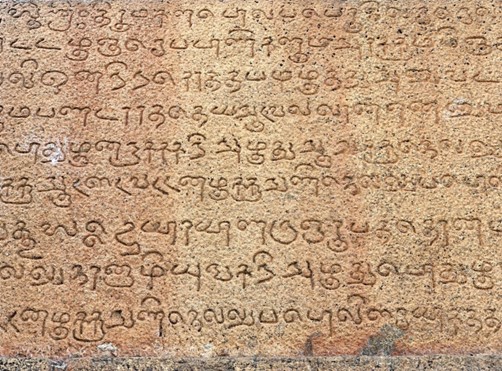 蓋蒂圖片社
蓋蒂圖片社在全世界,,有數(shù)千種語言面臨消亡的風(fēng)險,。據(jù)聯(lián)合國統(tǒng)計,每兩周就有一種土著語言消亡,。這對人類造成的損失難以估量,。語言中充滿了獨特的想法、概念和理解,,由于其他語言中并沒有對應(yīng)的詞匯,因此這些語言通常沒有翻譯,。正如語言學(xué)家阿納斯塔西婭·里爾所說,,語言不僅是社區(qū)文化和身份認(rèn)同的關(guān)鍵來源,它作為一種“重要的人類認(rèn)知信息的來源”,,對全世界有益,。
土著語言面臨風(fēng)險的一個重要原因是向數(shù)字時代的轉(zhuǎn)變。研究人員安德拉什·科爾奈開展的一項研究,,得出了令人擔(dān)憂的結(jié)果,。這項研究預(yù)測,,“只有不到5%的語言能在數(shù)字時代存活下去”,,該研究還警告有“證據(jù)證明數(shù)字鴻溝導(dǎo)致了語言的大規(guī)模消亡”,。
隨著人來越來越多通過數(shù)字工具進行溝通,主流數(shù)字平臺不支持的語言可能被遺忘,。研究人員為此創(chuàng)造了一個術(shù)語:“數(shù)字弱勢語言”,。
泰米爾語的處境
筆者使用的是全世界最古老的語言之一的泰米爾語。泰米爾語是美國副總統(tǒng)賀錦麗的母語,,她在接受副總統(tǒng)提名時提到了這種語言,。它也是谷歌(Google)CEO桑德拉·皮查伊的母語。圣雄甘地為了理解原始版本的有關(guān)倫理道德的著名作品《蒂魯古拉爾》(Thirukkural),,曾希望學(xué)習(xí)泰米爾語,。
有報告稱超過7,000萬人講泰米爾語,其中在美國有約25萬人,,它目前并未被認(rèn)定為是一種正在消亡的語言,。但我看到了它的數(shù)字弱勢地位。我小時候在美國和印度欽奈度過,。欽奈隸屬于泰米爾納德邦,,泰米爾語是該邦的官方語言。但我看到,,每年當(dāng)?shù)赜性絹碓蕉鄻?biāo)志,、產(chǎn)品標(biāo)識、商業(yè)對話和流行文化變成了英語,。在公共場合使用泰米爾語時,,會越來越多地被直譯成英語(拉丁字符)。
除了文化原因以外(在欽奈等偏好英語的地區(qū),,有時候泰米爾語會遭到歧視),,數(shù)字現(xiàn)實是這種轉(zhuǎn)變的主要驅(qū)動力。人們習(xí)慣了首先使用英語,,尤其是年輕人,,因為大多數(shù)計算機和手機都用英語設(shè)計。因此,,即使人們知道泰米爾語,,通常也會輸入英文字符。泰米爾語有247個字符,。一些技術(shù)人員正在開發(fā)工具,,以幫助提高泰米爾語輸入的效率,使其變成一種積極的體驗。筆者領(lǐng)導(dǎo)的DCKAP公司就是其中之一,,我們正在為使用泰米爾語的人設(shè)計一種新鍵盤,。我們的靈感來自創(chuàng)造中文解決方案的設(shè)計師。
最近幾個月,,顯然有一波新技術(shù)浪潮,,可能掀起變革。在數(shù)字時代,,生成式人工智能可以發(fā)揮巨大的作用,為語言注入新的活力,。
將AI變成傳承古代語言的家園
生成式AI令人們興奮的是,,它能“理解”和復(fù)制人類相互對話的方式。它能產(chǎn)生雪球效應(yīng),。使用ChatGPT和Bard等生成式AI的人越多,,這些工具就能更好地理解和復(fù)制語言。目前,,這些工具只精通主導(dǎo)互聯(lián)網(wǎng)的語言,,尤其是英語。
這為語言學(xué)家,、技術(shù)人員和正在將語言轉(zhuǎn)移到數(shù)字領(lǐng)域的其他人,,創(chuàng)造了巨大的機會。為面臨風(fēng)險的語言開發(fā)生成式AI工具,,將讓語言的使用者有機會教AI使用他們的母語進行自然的對話,。AI工具還能完善口筆譯工具,幫助人們用不同語言溝通,。數(shù)字世界對短語,、習(xí)語和觀點的意義理解和翻譯地越準(zhǔn)確,就會有越多人感覺他們可以用自己的母語表達自己,。
做這一切最緊迫的理由之一是出于商業(yè)目的,。在全世界有許多有才華的人們說著數(shù)千種語言,但他們目前在要求英語的許多大公司卻找不到工作,。隨著AI可以提供能捕捉想法和細微差別的即時翻譯,,人們能夠向講不同語言的同事表達自己的觀點,但不會影響公司的節(jié)奏,。
公司也可以進入新的消費者市場,。隨著AI技術(shù)改善了手機相機,人們可以用手機對向任何標(biāo)志或產(chǎn)品,,并立即翻譯成他們的母語,。目前全世界正在被使用的語言有7,000種,而大多數(shù)應(yīng)用只能翻譯不到200種語言。
當(dāng)然,,這也意味著要保證越來越多人能夠使用互聯(lián)網(wǎng)和AI工具,。目前約有三分之二人類(超過50億人)可以使用互聯(lián)網(wǎng)。
讓盡可能多的語言進入這個AI的新時代,,不只是一次機會,,而是勢在必行。如果希望加入AI革命的人們發(fā)現(xiàn),,他們的語言被排除在外,,他們自然會放棄自己的語言,并選擇更主流的語言,。但如果AI工具能支持夏威夷語,、阿魯科語和斯普蒂語等,就能拯救這些語言,,否則將為時已晚,。(財富中文網(wǎng))
本文作者卡西克·奇丹巴拉姆是綜合平臺提供商DCKAP的創(chuàng)始人兼CEO。
Fortune.com上發(fā)表的評論文章中表達的觀點,,僅代表作者本人的觀點,,不能代表《財富》雜志的觀點和立場。
翻譯:劉進龍
審校:汪皓
蓋蒂圖片社
在全世界,,有數(shù)千種語言面臨消亡的風(fēng)險,。據(jù)聯(lián)合國統(tǒng)計,每兩周就有一種土著語言消亡,。這對人類造成的損失難以估量,。語言中充滿了獨特的想法、概念和理解,,由于其他語言中并沒有對應(yīng)的詞匯,,因此這些語言通常沒有翻譯。正如語言學(xué)家阿納斯塔西婭·里爾所說,,語言不僅是社區(qū)文化和身份認(rèn)同的關(guān)鍵來源,,它作為一種“重要的人類認(rèn)知信息的來源”,對全世界有益,。
土著語言面臨風(fēng)險的一個重要原因是向數(shù)字時代的轉(zhuǎn)變,。研究人員安德拉什·科爾奈開展的一項研究,得出了令人擔(dān)憂的結(jié)果,。這項研究預(yù)測,,“只有不到5%的語言能在數(shù)字時代存活下去”,該研究還警告有“證據(jù)證明數(shù)字鴻溝導(dǎo)致了語言的大規(guī)模消亡”,。
隨著人來越來越多通過數(shù)字工具進行溝通,,主流數(shù)字平臺不支持的語言可能被遺忘,。研究人員為此創(chuàng)造了一個術(shù)語:“數(shù)字弱勢語言”。
泰米爾語的處境
筆者使用的是全世界最古老的語言之一的泰米爾語,。泰米爾語是美國副總統(tǒng)賀錦麗的母語,,她在接受副總統(tǒng)提名時提到了這種語言。它也是谷歌(Google)CEO桑德拉·皮查伊的母語,。圣雄甘地為了理解原始版本的有關(guān)倫理道德的著名作品《蒂魯古拉爾》(Thirukkural),,曾希望學(xué)習(xí)泰米爾語。
有報告稱超過7,000萬人講泰米爾語,,其中在美國有約25萬人,,它目前并未被認(rèn)定為是一種正在消亡的語言。但我看到了它的數(shù)字弱勢地位,。我小時候在美國和印度欽奈度過,。欽奈隸屬于泰米爾納德邦,泰米爾語是該邦的官方語言,。但我看到,每年當(dāng)?shù)赜性絹碓蕉鄻?biāo)志,、產(chǎn)品標(biāo)識,、商業(yè)對話和流行文化變成了英語。在公共場合使用泰米爾語時,,會越來越多地被直譯成英語(拉丁字符),。
除了文化原因以外(在欽奈等偏好英語的地區(qū),有時候泰米爾語會遭到歧視),,數(shù)字現(xiàn)實是這種轉(zhuǎn)變的主要驅(qū)動力,。人們習(xí)慣了首先使用英語,尤其是年輕人,,因為大多數(shù)計算機和手機都用英語設(shè)計,。因此,即使人們知道泰米爾語,,通常也會輸入英文字符,。泰米爾語有247個字符。一些技術(shù)人員正在開發(fā)工具,,以幫助提高泰米爾語輸入的效率,,使其變成一種積極的體驗。筆者領(lǐng)導(dǎo)的DCKAP公司就是其中之一,,我們正在為使用泰米爾語的人設(shè)計一種新鍵盤,。我們的靈感來自創(chuàng)造中文解決方案的設(shè)計師。
最近幾個月,,顯然有一波新技術(shù)浪潮,,可能掀起變革。在數(shù)字時代,生成式人工智能可以發(fā)揮巨大的作用,,為語言注入新的活力,。
將AI變成傳承古代語言的家園
生成式AI令人們興奮的是,它能“理解”和復(fù)制人類相互對話的方式,。它能產(chǎn)生雪球效應(yīng),。使用ChatGPT和Bard等生成式AI的人越多,這些工具就能更好地理解和復(fù)制語言,。目前,,這些工具只精通主導(dǎo)互聯(lián)網(wǎng)的語言,尤其是英語,。
這為語言學(xué)家,、技術(shù)人員和正在將語言轉(zhuǎn)移到數(shù)字領(lǐng)域的其他人,創(chuàng)造了巨大的機會,。為面臨風(fēng)險的語言開發(fā)生成式AI工具,,將讓語言的使用者有機會教AI使用他們的母語進行自然的對話。AI工具還能完善口筆譯工具,,幫助人們用不同語言溝通,。數(shù)字世界對短語、習(xí)語和觀點的意義理解和翻譯地越準(zhǔn)確,,就會有越多人感覺他們可以用自己的母語表達自己,。
做這一切最緊迫的理由之一是出于商業(yè)目的。在全世界有許多有才華的人們說著數(shù)千種語言,,但他們目前在要求英語的許多大公司卻找不到工作,。隨著AI可以提供能捕捉想法和細微差別的即時翻譯,人們能夠向講不同語言的同事表達自己的觀點,,但不會影響公司的節(jié)奏,。
公司也可以進入新的消費者市場。隨著AI技術(shù)改善了手機相機,,人們可以用手機對向任何標(biāo)志或產(chǎn)品,,并立即翻譯成他們的母語。目前全世界正在被使用的語言有7,000種,,而大多數(shù)應(yīng)用只能翻譯不到200種語言,。
當(dāng)然,這也意味著要保證越來越多人能夠使用互聯(lián)網(wǎng)和AI工具,。目前約有三分之二人類(超過50億人)可以使用互聯(lián)網(wǎng),。
讓盡可能多的語言進入這個AI的新時代,不只是一次機會,,而是勢在必行,。如果希望加入AI革命的人們發(fā)現(xiàn),,他們的語言被排除在外,他們自然會放棄自己的語言,,并選擇更主流的語言,。但如果AI工具能支持夏威夷語、阿魯科語和斯普蒂語等,,就能拯救這些語言,,否則將為時已晚。(財富中文網(wǎng))
本文作者卡西克·奇丹巴拉姆是綜合平臺提供商DCKAP的創(chuàng)始人兼CEO,。
Fortune.com上發(fā)表的評論文章中表達的觀點,,僅代表作者本人的觀點,不能代表《財富》雜志的觀點和立場,。
翻譯:劉進龍
審校:汪皓
GETTY IMAGES
Around the world, thousands of languages are in danger of going extinct. According to the United Nations, an indigenous language has been dying every two weeks. The loss to humanity is difficult to fathom. Languages are filled with unique ideas, concepts, and understandings that don’t always translate since other languages simply don’t have words for them. As linguist Anastasia Riehl put it, languages are not only a vital source of culture and identity for individual communities, but also benefit the world as “an invaluable source of information about human cognition.”
A big part of what endangers indigenous languages is the shift into the digital age. One particularly concerning study by researcher András Kornai predicted that “l(fā)ess than 5% of all languages can still ascend to the digital realm,” and warned that there is “evidence of a massive die-off caused by the digital divide.”
As humanity carries out more and more of its communications through digital tools, languages that aren’t carried or supported by dominant digital platforms are likely to be forgotten. Researchers have coined a term for this: “digitally disadvantaged languages.”
The curious case of Tamil
I speak one of the world’s oldest languages, Tamil. It’s the native tongue of Vice President Kamala Harris’ mother–and one that Harris referenced in accepting the vice presidential nomination. It’s also the first language of Google CEO Sundar Pichai. It’s the language that Mahatma Gandhi wanted to learn in order to understand the Thirukkural, a renowned work on ethics and morality, in its original form.
With reports suggesting that more than 70 million people speak Tamil, including about 250,000 in the United States, it is not currently considered a dying language. But I see how it is digitally disadvantaged. I spend time in both the United States and Chennai, India, where I grew up. Chennai is in the state of Tamil Nadu, where Tamil is the official language. But every year, I see English take over more and more of the signs, product labels, business conversations, and pop culture in the region. Even when Tamil is used in public places, it’s more and more often transliterated into English (Latin characters).
In addition to cultural reasons (like Tamil sadly being looked down on at times in places like Chennai, in favor of English), the digital reality is a major driving force in this shift. People, especially in younger generations, get used to making English the language they turn to first since most computers and phones are designed for English. So even when people know Tamil, they often type in English characters. In Tamil, we have 247 characters. Some technologists are building tools to help make typing Tamil an efficient, positive experience. DCKAP (the company I lead) is among them, working on a new keyboard for Tamil speakers. We take inspiration from designers who created a solution for the Chinese language.
In recent months, it’s become clear that a new wave of technology offers a potentially transformative effect. Generative AI can help a great deal in breathing new life into languages for the digital era.
Making AI a home for ancient tongues
Much of what excites people about generative AI is its ability to “understand” and replicate the ways humans talk to each other. It has a snowball effect. The more people use generative AI tools such ChatGPT and Bard, the better these tools become at understanding and replicating the language. Currently, they are only proficient in the languages that dominate the internet–especially English.
This presents a profound opportunity for linguists, technologists, and others who are working to move languages into the digital realm. Building generative AI tools for at-risk languages will give speakers a chance to teach AI how they speak their native tongues in natural conversations. AI tools will also improve translation and interpretation apps aimed at helping people communicate across different languages. The better the digital world understands and translates the intended meanings of phrases, idioms, and ideas, the more people will feel they can express themselves in their native languages.
One of the most pressing reasons to do all this is for business. There are talented people across the world who speak thousands of languages, and who currently cannot get jobs with many large corporations that may require English. With AI providing instant translations that capture ideas and nuances, people will be able to express themselves to colleagues who speak different languages without slowing down the pace of business.
Businesses will also be able to reach entire new markets of consumers. With AI technologies improving for phone cameras, people will be able to point their phones at any sign or product and have it instantly translated into their native tongue. Today, most such apps translate fewer than 200 of the 7,000 languages spoken around the world.
Of course, this also means ensuring that more and more people have access to the Internet and AI tools. Currently about two-thirds of humanity, more than 5 billion people, are online.
Building as many languages as possible into this new era of AI isn’t just an opportunity, it’s an imperative. If people looking to join the AI revolution find that their language precludes them from being a part of it, then they’ll naturally let it go and move to a more dominant language. But if AI tools become home to everything from Hawaiian to Arhuaco to Siphuti, these languages can be saved before it’s too late.
Karthik Chidambaram is the founder and CEO of DCKAP, an integration platform provider.
The opinions expressed in Fortune.com commentary pieces are solely the views of their authors and do not necessarily reflect the opinions and beliefs of Fortune.






